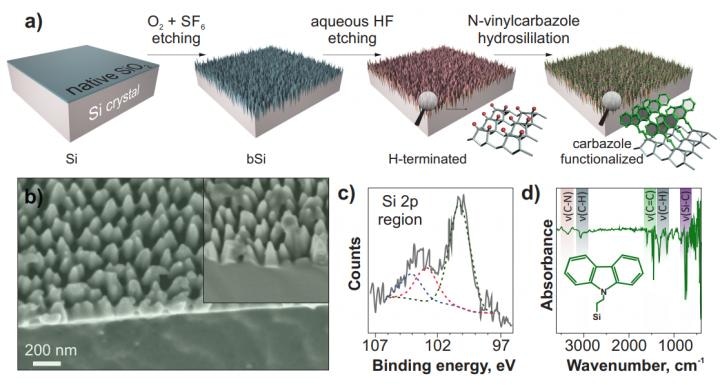Nov 28 2019
Researchers from Far Eastern Federal University (FEFU), Far Eastern Branch of the Russian Academy of Sciences, Swinburne University of Technology, and Melbourne Center for Nanofabrication have designed a black silicon-based ultrasensitive detector.
 Image Credit: FEFU press office.
Image Credit: FEFU press office.
The device can identify traces of nitroaromatic compounds and can be used to detect most of the explosives or more toxic pollutants for medical and forensic evaluations. The study was reported in ACS Sensors.
The new sensor is based on the so-called black silicon that is developed by high-performing reactive etching of commercially available silicon substrates. Etched silicon has a nanostructured spiky surface with exclusive optical properties. Once the surface was etched, it was covered by a monolayer of carbazole molecules.
This step is known as chemical functionalization because the bound molecules provide the substrate with a specific vital function, that is, the potential to attach and concentrate nitroaromatic compounds on the surface.
The carbazole monolayer makes the device sensitive to widespread nitroaromatic substances like o-nitrotoluene, 2,4-dinitrotoluene, nitrobenzene, etc. The sensor, however, does not react with other molecules such as toluene, benzene, tetrachloromethane, ethanol, methanol, and so on.
Nitroaromatic compounds can be found in the waste waters of paint plants or military facilities and are extremely dangerous for the environment. Moreover, they are parts of many explosives as well. Their detection in trace concentration represents an important and complex practical task.
Alexander Kuchmizhak, Research Associate, VR and AR Center of the Science and Technology, FEFU
Kuchmizhak continued “Our sensor platform identifies the presence of nitroaromatic compounds by means of registering the changes in the luminescence spectrum of the functional layer of carbazole that selectively reacts to nitroaromatic molecules.”
Kuchmizhak found that nanostructured black silicon used as the basis of the device could offer it an unprecedented dynamic measurement range and high sensitivity. In the laboratory, the sensor can provide details about the presence of harmful molecules in gases or liquids within several minutes.
According to Alexander Mironenko, the designer of the sensor and a senior research associate at the Institute of Chemistry, FEB RAS, “Combination of unique morphological and optical properties of black silicon being combined with easy-to-implement methods of surface chemistry used to functionalize silicon surface with carbazole molecules allowed to achieve unprecedented sensitivity.”
Our sensor is able to detect nitroaromatic compounds at concentrations down to ppt (part per trillion or 10-10%). Extremely broad dynamic measurement range is caused by the unique spiky morphology of black silicon that provides uneven local concentration of carbazole molecules creating surface sites with different sensitivity.
Alexander Mironenko, Senior Research Associate, Institute of Chemistry, FEB RAS
According to the researchers, the new sensor platform could be produced at a lower cost than the current analogs. Furthermore, the same sensor can be used several times and can become a part of gas sensor systems that ensure ecological and public safety.
The study participants represented Far Eastern Federal University, Institute of Chemistry and the Institute of Automation and Management Processes of the Far Eastern Branch of the Russian Academy of Sciences, Swinburne University of Technology, and Melbourne Center for Nanofabrication.
This research was supported by the Russian Science Foundation under the Grant No. 18-79-10091.